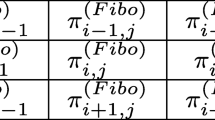Abstract
The multi-bit image steganography (Paul et al. Multimedia Tools and Applications 76(5):7445–7471, 2017) proposed by Paul et al. provides high embedding capacity, and adapts the embedding position of messages to image content. This paper investigates the security and robustness of multi-bit steganography. In detection resistant experiment, we embed secret messages into cover images with multi-bit image steganography to get corresponding stego images, and adopt a more popular steganalyzer (SRM) to extract features of cover images and stego images. The ensemble classifier is trained with default settings. The experimental results show detection resistance performance of multi-bit image steganography is poor. In robustness test, we embed secret messages into cover images with multi-bit image steganography to get stego images, and attack the stego images with Stirmark. Then, we extract the secret messages from the attacked stego images. The experimental results demonstrate that we can not recover the secret messages from the attacked stego images. Therefore, there are flaws in detection resistant test and robustness test of multi-bit image steganography.







Similar content being viewed by others
References
Andreas W, Pfitzmann A (1999) Attacks on steganographic systems. In: International workshop on information hiding, pp 61–76
Bas P, Filler T, Pevny T (2011) Break our steganographic system the ins and outs of organizing boss. In: International workshop on information hiding, pp 59–70
Fei P et al (2019) A reversible watermarking for authenticating 2D CAD engineering graphics based on iterative embedding and virtual coordinates. Multimedia Tools and Applications 78(19):26885–26905
Fei P et al (2020) Reversible data hiding based on RSBEMD coding and adaptive multi-segment left and right histogram shifting. Signal Process Image Commun 81:115715
Holub V, Fridrich J (2012) Designing steganographic distortion using directional filters. In: 2012 IEEE International workshop on information forensics and security, pp 234–239
Holub V, Fridrich J, Denemark T (2014) Universal distortion function for steganography in an arbitrary domain. EURASIP Journal on Information Security 2014(1):1–13
Huang H-C, Chang F-C (2016) Multi-Tier And Multi-Bit reversible data hiding with contents characteristics. Journal of Information Hiding and Multimedia Signal Processing 7(1):11–20
Huang H-C, Chang F-C, Yuh-Yih L (2017) Multi-Bit Reversible data hiding with prediction and difference alteration. Journal of Information Hiding and Multimedia Signal Processing 8(2):435–444
Jessica F, Goljan M, Rui D (2001) Reliable detection of LSB steganography in color and grayscale images. In: Proceedings of the 2001 workshop on Multimedia and security: new challenges, pp 27–30
Jessica F, Kodovsky J (2012) Rich models for steganalysis of digital images. IEEE Transactions on Information Forensics and Security 7(3):868–882
Jia D et al (2009) Imagenet: A large-scale hierarchical image database. In: 2009 IEEE conference on computer vision and pattern recognition, pp 248–255
Jumanto J (2018) An enhanced LSB-image steganography using the hybrid Canny-Sobel edge detection. Cybern Inform Technol 18(2):74–88
Ki-Hyun J, Yoo K-Y (2015) Steganographic method based on interpolation and LSB substitution of digital images. Multimedia Tools and Applications 74 (6):2143–2155
Kodovsky J, Fridrich J, Holub V (2012) Ensemble classifiers for steganalysis of digital media. IEEE Trans Inform Forensics and Security 7(2):432–444
Paul G, Davidson I, Mukherjee I, Ravi SS (2012) Keyless steganography in spatial domain using energetic pixels. In: International conference on information systems security, pp 134–148
Paul G, Davidson I, Mukherjee I, et al. (2017) Keyless dynamic optimal multi-bit image steganography using energetic pixels. Multimedia Tools and Applications 76(5):7445–7471
Pevný T, Filler T, Bas P (2010) Using high-dimensional image models to perform highly undetectable steganography. In: International workshop on information hiding, pp 161–177
Pragya G, Bhagat J (2019) Image steganography using LSB substitution facilitated by shared password. In: International conference on innovative computing and communications. Springer, Singapore, pp 369–376
Rafael T, Madeiro F (2016) Word-Hunt: A LSB steganography method with low expected number of modifications per pixel. IEEE Latin America Trans 14(2):1058–1064
Rengarajan A, Rayappan JBB (2012) An intelligent chaotic embedding approach to enhance stego-image quality. Inform Sci 193:115–124
Sarreshtedari S, Akhaee MA (2013) One-third probability embedding: a new± 1 histogram compensating image least significant bit steganography scheme. IET image Process 8(2):78–89
Swain G (2019) Very high capacity image steganography technique using quotient value differencing and LSB substitution. Arabian J Sci Eng 44(4):2995–3004
Yang H, Sun X, Sun G (2009) A high-capacity image data hiding scheme using adaptive LSB substitution. Radio Eng 18(4):509–516
Ye J, Ni J, Yi Y (2017) Deep learning hierarchical representations for image steganalysis. IEEE Transactions on Information Forensics and Security 12 (11):2545–2557
Zhang X, Yin Z (2017) Data hiding in multimedia. Chinese Journal of Nature 39(2):87–95
Zhi-Hui W, Chang C-C, Li M-C (2012) Optimizing least-significant-bit substitution using cat swarm optimization strategy. Inf Sci 192:98–108
Acknowledgements
This research work is partly supported by National Natural Science Foundation of China (61872003, U1636206,61860206004).
Author information
Authors and Affiliations
Corresponding author
Ethics declarations
Conflict of interests
None
Additional information
Publisher’s note
Springer Nature remains neutral with regard to jurisdictional claims in published maps and institutional affiliations.
Rights and permissions
About this article
Cite this article
Ke, L., Yin, Z. On the security and robustness of “Keyless dynamic optimal multi-bit image steganography using energetic pixels”. Multimed Tools Appl 80, 3997–4005 (2021). https://doi.org/10.1007/s11042-020-09807-4
Received:
Revised:
Accepted:
Published:
Issue Date:
DOI: https://doi.org/10.1007/s11042-020-09807-4




